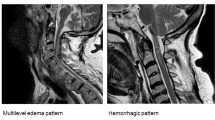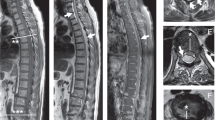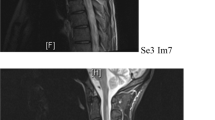Abstract
Study design: A case report of an upper thoracic spinal subdural hemorrhage which was managed successfully by conservative treatment.
Objectives: Spinal subdural hemorrhage is rare and can cause serious neurologic symptoms. Surgery is the most common treatment and is believed to prevent further neurologic injury. A case of an upper thoracic spinal subdural hemorrhage which was managed successfully by conservative therapy is reported.
Setting: Department of Orthopaedic Surgery, Tokai University School of Medicine, Isehara, Japan.
Methods: A 29-year-old woman presented with acute severe back pain. She experienced acutely developed weakness of both lower extremities, hypesthesia below T6 and urinary retention. Magnetic resonance imaging performed on the day of hospital admission revealed the existence of a subdural hematoma in the upper thoracic spine. Muscle strength of the lower extremities was grade 0 on admission, but improved slightly on day 1. The decision was made to manage the patient nonoperatively by corticosteroid and diuretic administration.
Results: Improvement was gradual but progressive. Muscle strength was grade 4 out of 5 on the 28th day. Magnetic resonance imaging at 3 months except for mild urinary retention.
Conclusions: Spinal subdural hemorrhage can be treated nonoperatively by correlating magnetic resonance image findings with the clinical condition.
Spinal Cord (2001) 39, 657–661.
Similar content being viewed by others
Log in or create a free account to read this content
Gain free access to this article, as well as selected content from this journal and more on nature.com
or
References
Brandt RA . Chronic spinal subdural haematoma Surg Neurol 1980 13: 121–123
Bondurant FJ et al. Acute spinal cord injury: a study using physical examination and magnetic resonance imaging Spine 1980 15: 368–370
Chaves CJ, Bianco E, Shibata MK, Almeida GM . Chronic spinal subdural hematoma Surg Neurol 1993 40: 435–436
Calhoun JM, Boop F . Spontaneous spinal subdural hematoma: case report and review of literature Neurosurgery 1991 29: 133–134
Foo D, Rossier AB . Preoperative neurological status in predicting surgical outcome of spinal epidural hematomas (Review) Surg Neurol 1981 15: 389–401
Katsuragawa Y et al. Case of spontaneous spinal subdural hematoma Seikeigeka 1994 45: 1779–1781
Kohli CM, Palmer AH, Gray GH . Spontaneous intraspinal hemorrhage causing paraplesia: a complication of heparin therapy An Surg 1974 179: 197–199
Kulkarni AV, Willinsky RA, Gray T, Cusimano MD . Serial magnetic resonance imaging findings for a spontaneously resolving spinal subdural hematoma: a case report Neurosurgery 1998 42: 398–401
Mavroudakis N, Levivier M, Rodesch G . Central cord syndrome due to a spontaneously regressive spinal subdural hematoma Neurology 1990 40: 1306–1308
Palmam SC . Spontaneous spinal epidural hematoma An Emerg Med 1980 9: 368–370
Schwerdtfeger K et al. Acute spinal intradural extramedullary hematoma: a non surgical approach for spinal cord decompression Neurosurgery 1990 27: 312–314
Tamano Y et al. Spontaneous resolution of idiopathic spinal subdural hematoma: case report No Shinkei Geka 1998 26: 1013–1018
Virender K et al. Chronic spinal subdural hematomas: report of two cases J Neurosurg 1985 63: 636–639
Zilkha A, Nicoletti MJ . Acute spinal subdural hematoma: case report J Neurosurg 1974 41: 627–630
Author information
Authors and Affiliations
Rights and permissions
About this article
Cite this article
Maeda, M., Mochida, J., Toh, E. et al. Nonsurgical treatment of an upper thoracic spinal subdural hemorrhage. Spinal Cord 39, 657–661 (2001). https://doi.org/10.1038/sj.sc.3101219
Published:
Issue date:
DOI: https://doi.org/10.1038/sj.sc.3101219



